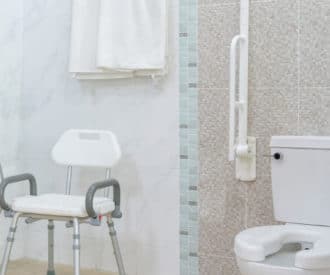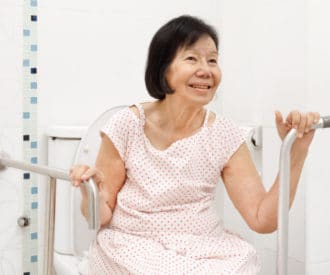
Many older adults wish to stay in their homes as they age. To make this a reality, a safe and supportive environment is essential. Senior home care expert Lance A. Slatton shares tips for creating a safe and comfortable living environment that promotes independence and well-being.
For many older adults, the desire to age in place – remaining in their own homes as they grow older – holds great appeal.
Aging in place gives seniors the opportunity to remain in familiar surroundings while maintaining their independence and autonomy.
However, creating a safe and supportive environment is essential for successful aging in place.
From fall prevention and accessibility modifications to medication management and social engagement, each strategy plays a vital role in promoting safety, comfort, and independence.
By adapting the home environment to meet changing needs, older adults can continue to thrive and flourish in the place they call home.
Here we'll share useful tips in 5 essential areas for creating a safe and comfortable living environment for seniors that promotes independence and well-being.
4 fall prevention strategies
Falls are one of the most significant risks to seniors' safety and independence. That’s why implementing measures to prevent falls is crucial.
1. Remove hazards
Conduct a thorough assessment of the home to identify potential tripping hazards, such as loose rugs, cluttered walkways, or uneven surfaces.
Remove or secure these hazards to create clear pathways throughout the home.
2. Install grab bars and handrails
Place grab bars and handrails in key areas, such as bathrooms and staircases, to provide support and stability.
Ensure they are securely anchored to withstand weight and pressure.
3. Improve lighting
Adequate lighting is essential for preventing falls, especially in typically dimly lit areas.
Install bright, energy-efficient LED bulbs and motion-activated lights to illuminate rooms, hallways, staircases, and entrances.
4. Consider assistive devices
Explore assistive devices, such as canes, walkers, or mobility aids to enhance stability and balance.
Ensure these devices are properly fitted and maintained to maximize effectiveness.
4 ways to adapt living spaces for accessibility
Creating an accessible home environment is essential for seniors with mobility limitations or disabilities.
1. Widen doorways
Modify doorways to accommodate wheelchairs or walkers by widening them if necessary.
Consider installing swing-clear hinges to maximize clearance.
2. Lower countertops and cabinets
Lower countertops and cabinets to a more accessible height to reduce reaching and bending.
Incorporate pull-out shelves and lazy susan turntables for easier access to items.
3. Install ramps
If stairs present a barrier, consider installing ramps with gentle slopes to facilitate entry and exit.
Ensure ramps are wide enough and have handrails for added safety.
4. Create a bedroom and bathroom on the main level
If possible, arrange for a bedroom and bathroom to be located on the main level to minimize the need to use stairs.
4 ways to increase bathroom safety
The bathroom poses unique challenges for seniors due to slippery surfaces and confined spaces. These top bathroom safety measures help reduce the risk of accidents.
1. Install grab bars
Place properly installed grab bars near the toilet, bathtub, and shower to provide support while getting in and out and during bathing.
Choose grab bars with a textured surface for a more secure grip.
2. Use non-slip strips for tub and shower
Place non-slip mats or adhesive strips in the bathtub or shower to prevent slips and falls.
Consider installing a walk-in shower with a low threshold for easier access or even a walk-in bathtub.
3. Install a raised toilet seat
A raised toilet seat can make it easier for seniors with mobility issues to sit down and stand up independently. Choose a seat with armrests for added support.
4. Secure toiletries
Keep toiletries within easy reach and securely fastened to prevent spills and clutter.
Use wall-mounted shelves or baskets to organize items without taking up valuable counter space.
4 ways to ensure safe medication management
Medication management is crucial for seniors' health and well-being, but it can be challenging to keep track of multiple prescriptions.
Using strategies to simplify medication management helps improve safety and the ability to take medication as prescribed.
1. Use pill organizers
Invest in pill organizers with compartments for each day of the week to simplify medication schedules. Consider automatic pill dispensers with alarms for reminders.
2. Create a medication list
Maintain an updated list of all medications, including dosage instructions and any allergies or contraindications.
Keep copies of the list in a visible location and also have additional copies on hand for caregivers or emergency responders.
3. Set up reminders
Use alarms, timers, or smartphone apps to remind seniors to take their medications at the prescribed times.
Consider enlisting the help of a caregiver or family member for additional support.
4. Organize refills
Establish a system for refilling prescriptions in advance to prevent running out of essential medications. Use mail-order pharmacies or automatic refills for added convenience.
4 ways to stay connected and engaged
Social isolation and loneliness can have negative effects on seniors' physical and mental health. Encouraging social connections and engagement is essential for overall well-being.
1. Stay connected with loved ones
Maintain regular communication with family members, friends, and neighbors through phone calls, video chats, or social media. Arrange for regular visits or outings to combat feelings of loneliness.
2. Participate in community activities
Encourage participation in community events, senior centers, or hobby groups to stay active and engaged.
Many organizations offer transportation services for seniors who may have difficulty getting around.
3. Volunteer or pursue hobbies
Engage in meaningful activities, such as volunteering, gardening, or crafts, to foster a sense of purpose and fulfillment.
Explore local resources and opportunities tailored to their interests and abilities.
4. Seek professional support
If feelings of isolation or depression persist, encourage older adults to seek support from mental health professionals, counselors, or support groups.
In addition, telehealth services offer convenient access to therapy and counseling from the comfort of home.
Recommended for you:
- 3 Tips to Choose Between Assisted Living vs In-Home Care
- Home Modifications for Seniors: A Room-by-Room Guide for Safety and Independence
- 7 Sources of Home Repair Assistance for Seniors
References: CDC, CDC, Elder Care Alliance, Live In Place Designs, National Library of Medicine, National Library of Medicine
This article wasn’t sponsored, but contains some affiliate links. If you buy through an affiliate link on our site, we may earn a small commission, at no additional cost to you, and we appreciate your support. We never link to products for the sole purpose of making a commission. Product recommendations are based on our honest opinions. For more information, see How We Make Money.
[optin-monster slug=”yxbytm35zhsdfopnw7qk”][optin-monster slug=”jvhyplxmb4umsjazxecn”]




